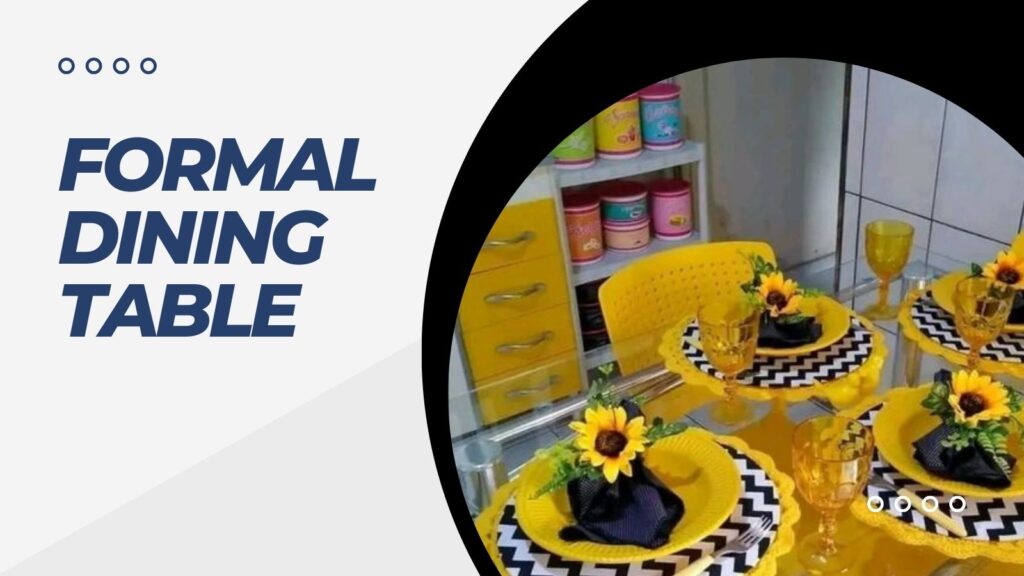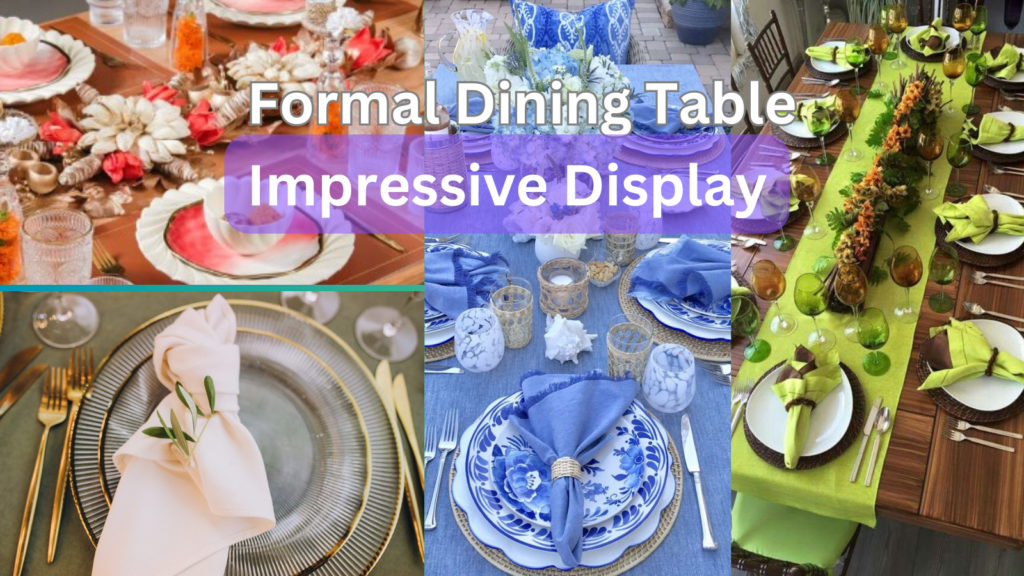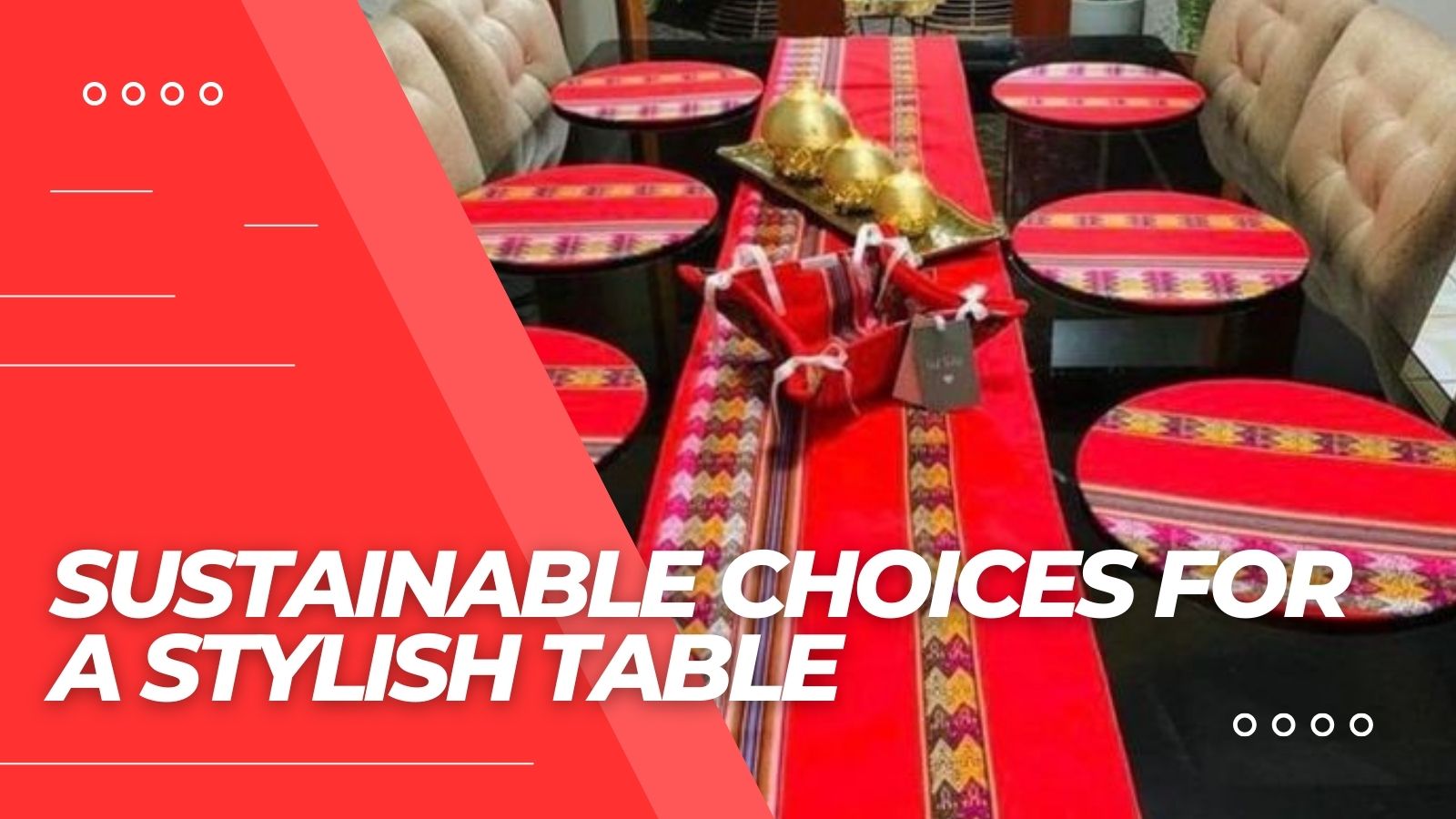Learn how to set a formal dining table with these expert tips. Impress your guests with a stunning and elegant table display for any special occasion.
How to Set a Formal Dining Table – Tips for an Impressive Display
When you invite guests for a formal dinner, the meal isn’t all that matters. The table setting also greatly impacts the dining experience. Setting a conventional eating table is a craftsmanship.. It combines tradition, creativity, and etiquette.
The table must be both elegant and practical. In this guide, I’ll walk you through some easy to follow tips that will help you set a formal dining table like a pro. These tips will elevate your presentation at any event. They apply to holiday dinners, weddings, and upscale dinner parties.
Understanding the Basics of a Formal Dining Table Setup
Before diving into the specifics of setting up the table, let’s first cover the essentials. They form the foundation of a formal dining setup.
1. Table Linens: The Foundation of Your Setup
Start with a high quality tablecloth that fits the size of your dining table. Linen and cotton are popular for formal settings. They are luxurious and durable. Neutral colors like white, ivory, or soft grays are timeless and versatile. You can also try deeper hues like navy or burgundy for a more dramatic effect.
To add dimension to your setup, consider layering with placemats or chargers. They protect your tablecloth from spills and create a refined look. Use placemats in complementary colors or materials. Woven textures or metallics add flair.
2. Dinnerware: Building Your Plate Settings
A formal dining table is incomplete without the right dinnerware. Classic pieces like a dinner plate, salad plate, and bread plate are a must for a multi course meal. For formal events, use porcelain or bone china. Their fine craftsmanship and delicate designs add sophistication.
For a modern but formal look, mix and match plates from different sets. Just ensure they complement each other in style and color.
3. Glassware & Cutlery: Attention to Detail
Your glassware should be as carefully selected as your plates. At the minimum, you’ll need three glasses per guest: a water glass, a red wine glass, and a white wine glass. Place the glasses above the knife on the right side of the plate. For extra formality, you can add a champagne flute or a dessert wine glass.
Cutlery can be a bit more complex. The rule is simple: start from the outside and work your way in. Place forks to the left of the plate, with the salad fork on the outside and the dinner fork closest to the plate. On the right side, place the knife next to the plate, blade facing inward, followed by the soup spoon on the outside.
Step by Step Guide to Setting the Table
Now that you’ve got your essentials in place, let’s break down the process step by step.
Step 1: Start with the Tablecloth and Runner
Lay the tablecloth over the table, making sure it hangs evenly on all sides. A well ironed tablecloth without wrinkles creates a polished look. To add visual interest, place a table runner on the table. Use it lengthwise or horizontally for a more modern look.
Step 2: Positioning Plates and Chargers
Start by placing a charger or service plate at each seat, about an inch from the edge of the table. The charger serves as the base for other plates and won’t be removed until after the first course. Place the dinner plate on top of the charger, and then the salad plate if you’re serving one.
Step 3: Adding Silverware – The Right Order
The placement of silverware follows the courses. Place the forks to the left of the plate. The salad fork goes on the outside, and the dinner fork, closest to the plate. Place the knives and spoons to the right. The knife, with the blade facing in, goes closest to the plate, then the soup spoon. If there’s a dessert spoon, place it horizontally above the plate.
Step 4: Arranging Glassware
Starting from the right, place the water glass directly above the knife. Next to it, arrange the wine glasses. The white wine glass goes outwardly. The red wine glass goes next to the water glass. If you’re serving champagne, the flute can go behind the wine glasses or to the right.
Step 5: Napkins – Fold or Ring?

Napkins can either be placed on the plate, to the left of the forks, or elegantly folded into a napkin ring. In formal settings, a neatly folded napkin adds sophistication. So does one in a decorative ring. There are many ways to fold napkins. You can make simple triangles, fans, or even intricate designs. It depends on the occasion.
Step 6: Personal Touches
For a truly impressive display, add personal touches. Consider place cards or custom name tags for each guest. This not only helps with seating but also makes the table feel more personalized. For centerpieces, keep them elegant but functional. Fresh flowers or candles are great. But, don’t obstruct guests’ view across the table.
Pro Tips for Elevating Your Dining Table Setup
Now that you’ve mastered the basics, let’s share some pro tips. They will help you elevate your formal dining table.
Tip 1: Balance Functionality and Aesthetics
You want your table to be beautiful, but not overcrowded. Ensure guests have room to eat and drink without bumping elbows or knocking over glasses. Keep decorations balanced—less is often more in formal settings.
Tip 2: Play with Texture and Color
Formal doesn’t have to mean boring. Mix materials like linen, satin, and velvet for table linens. Use different shades within a cohesive color palette. Adding metallic touches, like gold plated cutlery or silver candle holders, can boost elegance.
Tip 3: Use Seasonal or Theme Based Decorations
Incorporating seasonal elements or a theme can make the experience more memorable. Use fall leaves or pinecones for a Thanksgiving dinner. For a spring wedding, use pastel colors and blossoms.
Tip 4: Proper Lighting
The right lighting can elevate your table setting and create the perfect ambiance. For an intimate feel, use soft lighting, such as candles or dimmable chandeliers. Ensure the lighting doesn’t cast unflattering shadows or disrupt the conversation.
Recipes That Pair Well with a Formal Table Setting
Your food should impress as much as your table setting. Here are a few recipes to complement your formal dinner.
Starter: Mini Quiche with Goat Cheese and Herbs
These bite sized appetizers are easy to make. They look beautiful on small plates. The tangy goat cheese combined with fresh herbs will whet your guests’ appetites.
Main Course: Beef Wellington
A classic for formal dinners, Beef Wellington is a show stopping dish. The tender beef, wrapped in puff pastry with a mushroom filling, is a stunning dish. It looks perfect and tastes far and away superior.
Dessert: Crème Brûlée
This elegant dessert is the perfect way to end your formal dinner. The creamy custard paired with the caramelized sugar topping is always a crowd pleaser. Plus, the individual ramekins look great on the table.
Final Touches for an Unforgettable Dining Experience

Music: Play soft, instrumental background music to set the evening’s tone. It should complement the conversation.
Serving Etiquette: Remember the basic rule: serve from the left, clear from the right. This small etiquette touch can keep a formal, polished atmosphere during the meal.
Conversation & Hospitality: The table setting sets the stage. Your hospitality will leave the lasting impression. Encourage chat, welcome your guests, and enjoy the evening.
Conclusion
Setting a formal dining table may seem daunting at first. With some detail and a few personal touches, you can create a memorable, elegant display. It’s easy to do. Using these tips with your style will impress your guests. You’ll create a dining experience they’ll cherish. Happy hosting!

is a digital marketing consultant with a passion for advanced living, is the man behind this blog, where he shares his love for all things kitchen and culinary trends to help you elevate your cooking experience.



